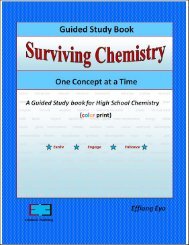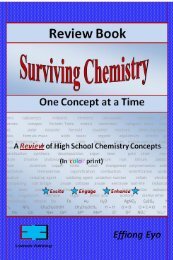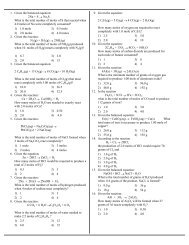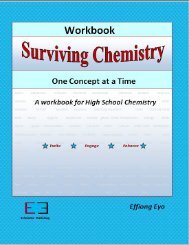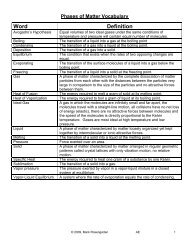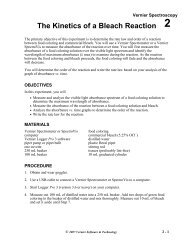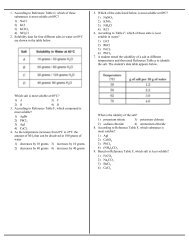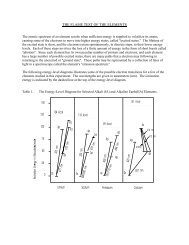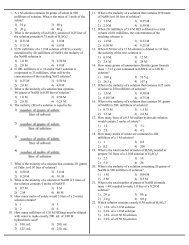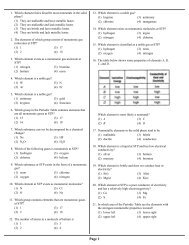Kinetics, Thermodynamics and Equilibrium - Revsworld
Kinetics, Thermodynamics and Equilibrium - Revsworld
Kinetics, Thermodynamics and Equilibrium - Revsworld
You also want an ePaper? Increase the reach of your titles
YUMPU automatically turns print PDFs into web optimized ePapers that Google loves.
2) Temperature<br />
This directly affects the speed of the colliding particles. The higher the temperature, the faster the particles are<br />
moving, <strong>and</strong> therefore they collide with more energy. This gives more effective collisions in the same unit time,<br />
increasing the rate of reaction.<br />
WHICH HAS A HIGHER RATE OF COLLISIONS? CARS TRAVELLING AT 30 MPH OR 100 MPH?<br />
If you want to preserve batteries that you are not using, put them in the refrigerator. This will slow down the chemical<br />
reaction so that the batteries last longer. Try using a Walkman in sub-freezing temperatures. You might notice that<br />
the tapeplaysalotslowerthanusual. Devices that have moving parts that run on batteries usually have an<br />
operating range of temperatures.<br />
The Bunsen burner heats up reactants. Why? To get the molecules to move faster <strong>and</strong> collide more frequently so that<br />
the reaction happens faster <strong>and</strong> you don’t have to sit around all day waiting for it to finish reacting!<br />
3) Concentration<br />
This affects the orientation of the colliding particles. The more particles there are in a given volume, the greater the<br />
chance for collision, the greater the chance for proper orientation, the greater the chance for effective collisions, <strong>and</strong><br />
the higher the rate. An increase in pressure for gases is the same as an increase in concentration, since the gas<br />
molecules are being pushed closer together, resulting in more collisions <strong>and</strong> a faster rate.<br />
WHICH HAS A HIGHER RATE OF COLLISIONS? A PARKING LOT WITH 10 CARS OR 100?<br />
Acids are generally compounds containing H + ions dissolved in water. When reacting acids with metals (like in the<br />
demonstration that filled up the balloon where hydrochloric acid reacted with zinc metal to produce the hydrogen gas),<br />
the higher the concentration of the acid is, the more collisions there will be between the acid molecules <strong>and</strong> the metal,<br />
making the reaction faster. Highly concentrated acid will eat away metals faster.<br />
4) Surface area<br />
The more surface that is exposed, the more surface that can undergo effective collisions. Crushing a salt cube to<br />
dissolve it exposes fresh surface to react. Smaller particles of the same mass of a large cube of substance have a<br />
higher surface area. Affects only solid reactants, since liquids <strong>and</strong> gases have maximum surface area (no chunks to<br />
break up).<br />
Take two bricks four feet apart <strong>and</strong> throw them at each other. Now, break those bricks up into twenty pieces each <strong>and</strong><br />
throw the pieces at each other from four feet away. Which situation will give you a better chance of a collision? If you<br />
have more pieces, there is a better chance of collision. This is why higher surface area (smaller particles) gives a<br />
faster reaction.<br />
Crushed garlic has more surface area than a whole clove of garlic, so it will give its flavor to the food you put it in more<br />
readily.<br />
10. grams of zinc powder will react faster with 2.0 M hydrochloric acid than a 10. gram chunk of mossy zinc.<br />
Take two cars, both unpainted. One is in perfect condition, the other has been scratched up. The one that has been<br />
scratched up has more surface exposed than the one in perfect condition, <strong>and</strong> will therefore rust faster.<br />
© 2009, Mark Rosengarten AE 4



